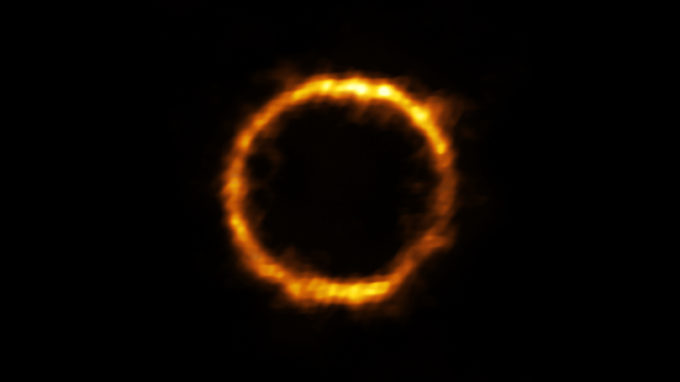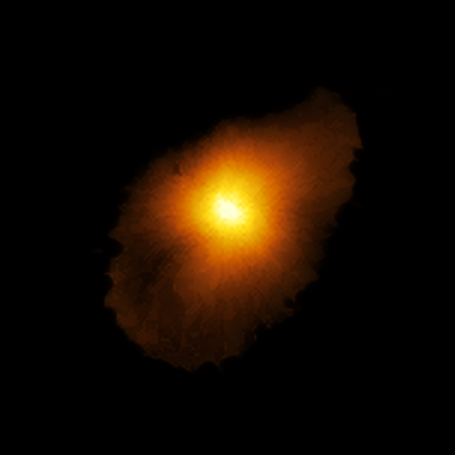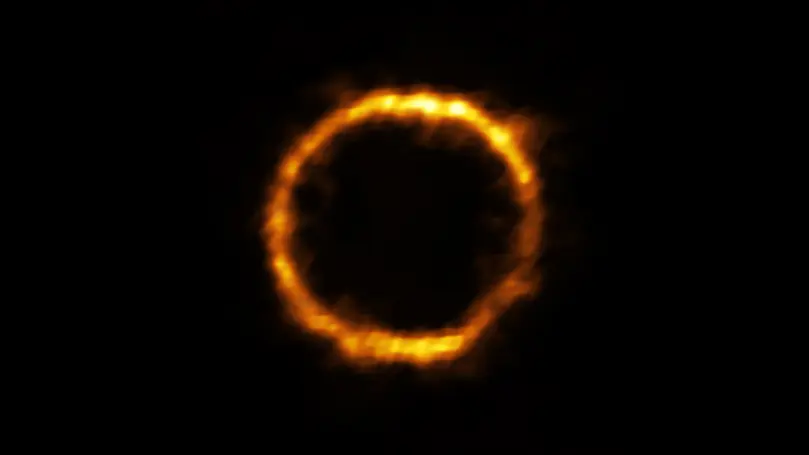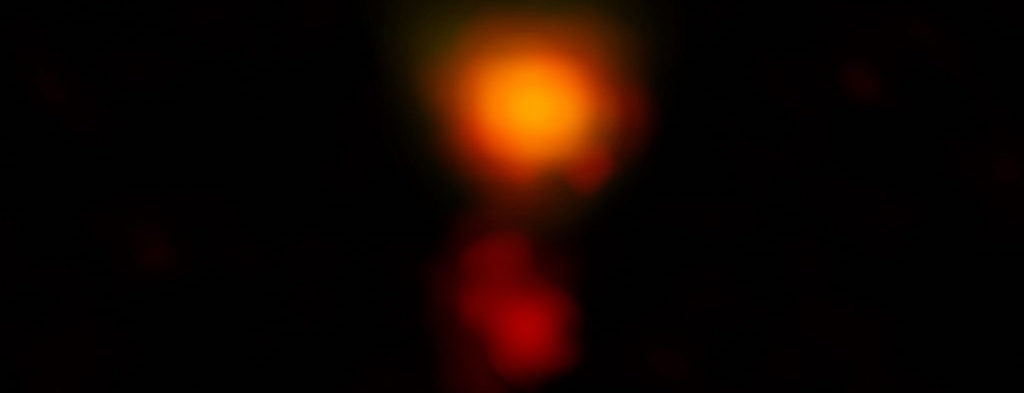ALMA sees most distant Milky Way look-alike
Astronomers using the Atacama Large Millimeter/submillimeter Array (ALMA), have revealed an extremely distant and therefore very young galaxy that looks surprisingly like our Milky Way. The galaxy is so far away its light has taken more than 12 billion years to reach us: we see it as it was when the Universe was just 1.4 billion years old. It is also surprisingly unchaotic, contradicting theories that all galaxies in the early Universe were turbulent and unstable. This unexpected discovery challenges our understanding of how galaxies form, giving new insights into the past of our Universe.
“This result represents a breakthrough in the field of galaxy formation, showing that the structures that we observe in nearby spiral galaxies and in our Milky Way were already in place 12 billion years ago,” says Francesca Rizzo, PhD student from the Max Planck Institute for Astrophysics in Germany, who led the research published today in Nature. While the galaxy the astronomers studied, called SPT0418-47, doesn’t appear to have spiral arms, it has at least two features typical of our Milky Way: a rotating disc and a bulge, the large group of stars packed tightly around the galactic centre. This is the first time a bulge has been seen this early in the history of the Universe, making SPT0418-47 the most distant Milky Way look-alike.
“The big surprise was to find that this galaxy is actually quite similar to nearby galaxies, contrary to all expectations from the models and previous, less detailed, observations,” says co-author Filippo Fraternali, from the Kapteyn Astronomical Institute, University of Groningen in the Netherlands. In the early Universe, young galaxies were still in the process of forming, so researchers expected them to be chaotic and lacking the distinct structures typical of more mature galaxies like the Milky Way.
Studying distant galaxies like SPT0418-47 is fundamental to our understanding of how galaxies formed and evolved. This galaxy is so far away we see it when the Universe was just 10% of its current age because its light took 12 billion years to reach Earth. By studying it, we are going back to a time when these baby galaxies were just beginning to develop.
Because these galaxies are so far away, detailed observations with even the most powerful telescopes are almost impossible as the galaxies appear small and faint. The team overcame this obstacle by using a nearby galaxy as a powerful magnifying glass — an effect known as gravitational lensing — allowing ALMA to see into the distant past in unprecedented detail. In this effect, the gravitational pull from the nearby galaxy distorts and bends the light from the distant galaxy, causing it to appear misshapen and magnified.
The gravitationally lensed, distant galaxy appears as a near-perfect ring of light around the nearby galaxy, thanks to their almost exact alignment. The research team reconstructed the distant galaxy’s true shape and the motion of its gas from the ALMA data using a new computer modelling technique. “When I first saw the reconstructed image of SPT0418-47 I could not believe it: a treasure chest was opening,” says Rizzo.
“What we found was quite puzzling; despite forming stars at a high rate, and therefore being the site of highly energetic processes, SPT0418-47 is the most well-ordered galaxy disc ever observed in the early Universe,” stated co-author Simona Vegetti, also from the Max Planck Institute for Astrophysics. “This result is quite unexpected and has important implications for how we think galaxies evolve." The astronomers note, however, that even though SPT0418-47 has a disc and other features similar to those of spiral galaxies we see today, they expect it to evolve into a galaxy very different from the Milky Way, and join the class of elliptical galaxies, another type of galaxies that, alongside the spirals, inhabit the Universe today.
This unexpected discovery suggests the early Universe may not be as chaotic as once believed and raises many questions on how a well-ordered galaxy could have formed so soon after the Big Bang. This ALMA finding follows the earlier discovery announced in May of a massive rotating disc seen at a similar distance. SPT0418-47 is seen in finer detail, thanks to the lensing effect, and has a bulge in addition to a disc, making it even more similar to our present-day Milky Way than the one studied previously.
Future studies will seek to uncover how typical these ‘baby’ disc galaxies really are and whether they are commonly less chaotic than predicted, opening up new avenues for astronomers to discover how galaxies evolved.
Additional Information
This research was presented in the paper “A dynamically cold disk galaxy in the early Universe” to appear in Nature (doi: 10.1038/s41586-020-2572-6).
The team is composed of F. Rizzo (Max Planck Institute for Astrophysics, Garching, Germany [MPA]), S. Vegetti (MPA), D. Powell (MPA), F. Fraternali (Kapteyn Astronomical Institute, University of Groningen, the Netherlands), J. P. McKean (Kapteyn Astronomical Institute and ASTRON, Netherlands Institute for Radio Astronomy), H. R. Stacey (MPA, Kapteyn Astronomical Institute and ASTRON, Netherlands Institute for Radio Astronomy) and S. D. M. White (MPA).
The original press release was published by the European Southern Observatory (ESO) an ALMA partner on behalf of Europe.
The Atacama Large Millimeter/submillimeter Array (ALMA), an international astronomy facility, is a partnership of the European Organisation for Astronomical Research in the Southern Hemisphere (ESO), the U.S. National Science Foundation (NSF) and the National Institutes of Natural Sciences (NINS) of Japan in cooperation with the Republic of Chile. ALMA is funded by ESO on behalf of its Member States, by NSF in cooperation with the National Research Council of Canada (NRC) and the Ministry of Science and Technology (MOST) and by NINS in cooperation with the Academia Sinica (AS) in Taiwan and the Korea Astronomy and Space Science Institute (KASI).
ALMA construction and operations are led by ESO on behalf of its Member States; by the National Radio Astronomy Observatory (NRAO), managed by Associated Universities, Inc. (AUI), on behalf of North America; and by the National Astronomical Observatory of Japan (NAOJ) on behalf of East Asia. The Joint ALMA Observatory (JAO) provides the unified leadership and management of the construction, commissioning and operation of ALMA.
Images



Videos
The video is available in 4K UHD.
The foreground galaxy is not visible in the ALMA images of SPT0418-47 because it is too faint at the wavelengths used. The blue colour used in this schematic to represent this foreground galaxy is artificial.
Credit:ALMA (NRAO/ESO/NAOJ)/Luis Calçada (ESO)
SPT0418-47 is gravitationally lensed by a nearby galaxy, appearing in the sky as a near-perfect ring of light, shown at the start of the video. At the end, we see the image of SPT0418-47 that astronomers obtained when they used a new computer modelling technique to reconstruct its real shape and motion of gas. Credit:ALMA (NRAO/ESO/NAOJ)/Martin Kornmesser (ESO)
Contacts
-
Nicolás Lira
Education and Public Outreach CoordinatorJoint ALMA Observatory, Santiago - ChilePhone: +56 2 2467 6519Cel: +56 9 9445 7726Email: [email protected] -
Bárbara Ferreira
ESO Media Manager -
Iris Nijman
News and Public Information ManagerNational Radio Astronomy Observatory Charlottesville, Virginia - USACel: +1 (434) 249 3423Email: [email protected] -
Masaaki Hiramatsu
Education and Public Outreach Officer, NAOJ Chile



